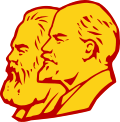Transmission belt
The topic of this article may not meet Wikipedia's general notability guideline. Please help to demonstrate the notability of the topic by citing reliable secondary sources that are independent of the topic and provide significant coverage of it beyond a mere trivial mention. If notability cannot be shown, the article is likely to be merged, redirected, or deleted. Find sources: "Transmission belt" – news · newspapers · books · scholar · JSTOR (February 2025) (Learn how and when to remove this message) |
Transmission belt is a Marxist–Leninist analogy to describe interactions of the communist party with the people in a communist state via mass organizations, such as trade unions. All these institutions worked under the party's leadership.[1] Examples are the All-Union Central Council of Trade Unions of the Soviet Union and the All-China Federation of Trade Unions, were and are transmission belt organisations.[2]
The term originates[citation needed] from Vladimir Lenin's speech to the 8th All-Russian Congress of Soviets, the All-Russian Central Council of Trade Unions and the Moscow City Council of Trade Unions, on 30 December 1920.[3]
References
[edit]Books
[edit]- Adam, Jan (2016). Why Did the Socialist System Collapse in Central and Eastern European Countries?: The Case of Poland, the Former Czechoslovakia and Hungary. Palgrave Macmillan. ISBN 978-0-312-12879-1.
- Sakwa, Richard (2002). Russian Politics and Society. Taylor & Francis. ISBN 0-415-22752-6.
- Simon, Karla W. (2013). Civil Society in China: The Legal Framework from Ancient Times to the "New Reform Era". Oxford University Press. ISBN 978-0-19-976589-8.
Footnotes
[edit]- ^ Adam 2016, p. 94.
- ^ Sakwa 2002, p. 319; Simon 2013, p. 169.
- ^ Lenin, Vladimir. "The Trade Unions, The Present Situation And Trotsky's Mistakes". Lenin’s Collected Works, 1st English Edition, Progress Publishers, Moscow, 1965, Volume 32, pages 19-42. Progress Publishers. Retrieved 27 December 2013.
